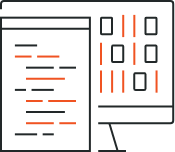
The Pros and Cons of Choosing ReactJS to Build Your Project
ReactJS is popular, but is it a good choice for your project? Explore ReactJS pros and cons before you decide.
Michał Kwilman18 March 2021
Build cross-platform mobile applications with Flutter.
Back in the days of Objective C/Swift and Java/Kotlin as primary languages for mobile development, building apps was expensive. For you had to build two separate apps, creating an app took twice as work.
With cross-platform toolkits like Flutter, you can now develop an app for iOS and Android with a single codebase. This benefits web applications as well.
The effect – viable mobile application development for you and your business. See how investing in Flutter mobile development can benefit your idea. Learn when to use it and how does it compare to React Native.
Experience native performance on any device.

Rapid development

Native performance

Flexible UI

Less coding

Time-to-market

Simple logic
*Flutter User Survey
Tap into the benefits of Flutter for businesses of any size and industry.

Cross-platform
Target every device with one technology.

Growing adoption
Join growing community of companies adopting Flutter to develop their ideas.

Viable choice
Reduce the development time, making it less expensive to create an app.
Flutter is Google’s open-source SDK for creating cross-platform applications. It uses Dart as a programming language, ensuring a single codebase for your project. Introduced by Google in 2017, Flutter has been growing since, attracting a developers’ community and companies interested in rapid development of their apps.
This free toolkit enables software developers to simultaneously build mobile apps for iOS and Android. From a business perspective, Flutter offers the possibility to significantly reduce the development time and cost. This impacts both company’s bottom line and time-to-market for their product.
Companies using Flutter include Alibaba, Tencent, Google, eBay and Square.
Choosing Flutter for mobile development was considered quite a bold move some time ago. However, right after finishing my first commercial project in Flutter, it was clear that it was the right choice. Not only is the application efficient, but also its development takes a short time.
Flutter is definitely not the first framework making it easier and less expensive to create cross-platform application. It has, however, some advantage that might change how many developers approach mobile app development.
For Android applications, Flutter can reduce the build time, offering intuitive tools, improving state management, and allowing to follow well known architectures like MVI. If you want your app to run on iOS, developers also don’t have to re-learn how they approach mobile development. Flutter offers equivalents for iOS elements, making it easy to adopt for experienced iOS developers.
In all, Flutter is a way to create apps faster, without extensive trainings, without comprising quality and performance.
Flutter is a viable choice for cross-platform development for mobile apps. It is easy to setup and uses a single codebase for all devices. Although it Flutter requires getting acquainted with Dart, its syntax is simple and most developers familiar with JavaScript will find it quite easy to adopt.
If you use material design for your project – it’s even better! Remember that it’s a design language also introduced by Google, so these two are definitely a match. This way, you will ensure native performance and responsiveness your app’s content needs.
Compared to React Native, Facebook’s cross-platform framework, Flutter is good for UIs based widget sets, offers good documentation and toolkit, is stable and has a growing community of developers and businesses.
We follow a proven process to deliver your project.
Flutter is a free, open-source toolkit. Developing your app with Flutter will require hiring software developers, whether by building your in-house team or investing in software outsourcing. The cost of the latter will depend on the scope of your project and hourly rates of a software development company you choose.
The cost of mobile development usually depends on the type of the project (e.g. game, business, entertainment, etc.), desired platforms, business logic, number of features, integrations, etc.
If you’re not sure about the details of your app architecture, software development team can also help you with this, as well as with choosing the right tech stack for your project.
At SoftwareHut, we’re a team of 200+ experienced software developers, ready to deliver your project. With over 200 projects delivered for our clients, we know our craft when it comes to bespoke software development.
We’re an extended team, which means we can join your project at any time, working hand-in-hand with your in-house software developers. You don’t have a team? No worries, we take on entire projects, too.
IT professionals
projects delivered
client satisfaction
What our clients say about us
Take a look at our articles on this subject.

ReactJS is popular, but is it a good choice for your project? Explore ReactJS pros and cons before you decide.
Michał Kwilman18 March 2021

What is the cost of software development? Time and Materials and Fixed Price are the most common billing methods - let's compare them!
Thomas Birk04 March 2021

Offering design services, ExtraHut needed to have access to software developers. Read how we support them with an extended team model.
Karol Średziński25 February 2021
We’ve covered some of the most frequently asked questions to make your decision as straightforward as possible.
Flutter is a cross-platform mobile development framework introduced by Google in 2017. Since then, it has been growing its adoption amongst software developers and companies looking for solutions to reduce the time and cost of mobile application development.
As a toolkit for cross-platform app development, it is an alternative to React Native created by Facebook in 2015. Although they differ when it comes to language and app architecture, the main idea is to create apps for different platforms easier and with less code required.
Today, both frameworks to choose when it comes to application development.
If you or your team are using JavaScript, looking for more mature solution with bigger adoption, and want to benefit from architecture based on components, then React Native is what you need.
Flutter, on the other hand, offers a good performance, is relatively easy to learn, and supports widget-sets to create flexible UIs.
To create applications with Flutter, you first need to know Dart. It is a programming language with a syntax similar to JavaScript. Also, developers familiar with C++/Java won’t have problems with quickly adopting Dart.
Today, Flutter is the main competitor of React Native when it comes to cross-platform development. Its popularity has been growing steadily over the last three years and we will continue to see its growth.
Also, big companies like Alibaba, Tencent, Google, eBay and Square now use Flutter, which is a prove that it can support big, demanding projects. Finally, it is an alternative to React Native and its limitations.